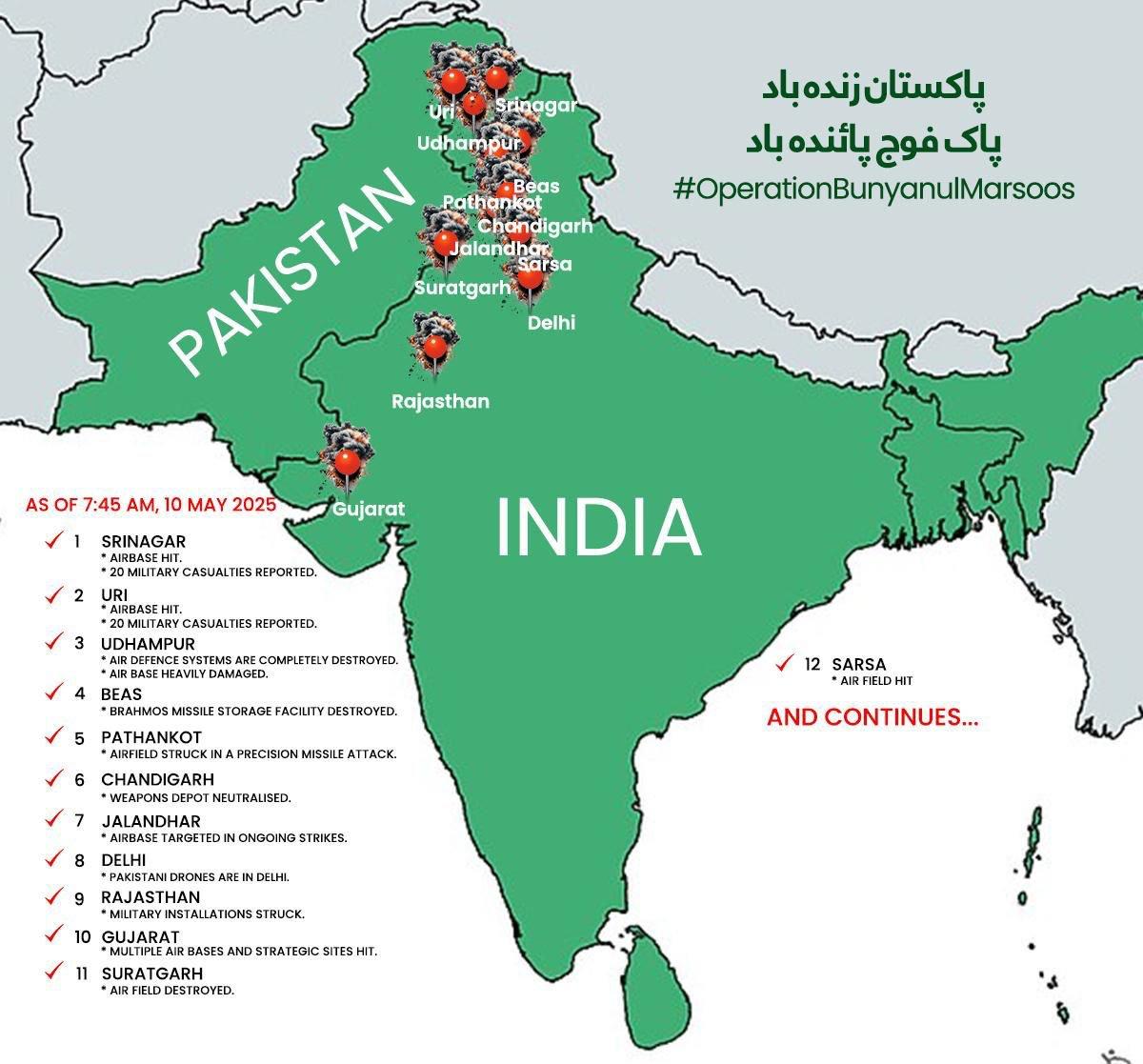Islamabad: Indian started war through its operation Sindoor backfiring with achieving failure after failure in last few days. Pakistan weighed and waited before responding while it had been defending all the attack successfully.
Fighting Terrorists like India or Indian backed terrorists was a history of Pakistan before 1947 even. At least 5 fighter planes were downed even at the start of the Indian failed operation Sindoor.
BREAKING: Pakistan hits India's Udhampur Air Base with 3 missiles. Visual confirmation in the video! pic.twitter.com/fmbQMeRK7a
— World Times (@WorldTimesWT) May 10, 2025
Breaking: Smoke is seen rising after a loud explosion from India's Udhampur Air Base. The base was targeted by Pakistan. pic.twitter.com/frK475ARRc
— World Times (@WorldTimesWT) May 10, 2025
In a major escalation of the ongoing conflict, Pakistan has significantly expanded its military operations against India, deploying a combination of drone and ballistic missile attacks targeting strategic locations across the border.
Among the weapons used is the Fateh-1, a domestically developed guided missile, signaling a shift in Pakistan’s strategic posture.
The campaign, now officially named Operation Bunyan Ul Marsoos, draws its title from a powerful Quranic reference, symbolizing a “solid structure” or a “wall firmly cemented together.”
The phrase, deeply rooted in Islamic scripture, is often interpreted as a metaphor for unbreakable unity and strength.
READ MORE: Aurangzeb Ahmed Goes Viral: PAF Pilot Becomes Top Google Search in Pakistan
By invoking this title, Pakistan appears to be underscoring its message of national resolve and cohesion in the face of perceived external threats.
According to reports from Pakistani state media, the most recent wave of strikes occurred in the early hours of Saturday, targeting multiple high-value sites within Indian territory.
These attacks follow an earlier offensive on Friday, during which 26 Indian locations were reportedly hit using a combination of missile salvos and drone raids, marking one of the most serious escalations in recent memory.
This latest phase of engagement comes in direct retaliation to India’s Operation Sindoor, a military campaign that Pakistan has described as provocative and aggressive.
In response, Pakistan’s leadership has adopted a more assertive stance, activating new missile systems and escalating the scope and reach of its retaliatory operations.
Indian Sirsa Airbase destroyed in Pakistani attack. 🛑🛑🛑 https://t.co/Tid363w1ca pic.twitter.com/tyWZUXWKs7
— The Intel Consortium (@IntelPk_) May 10, 2025
One of the focal points of global attention is the Fateh-1 missile, which played a prominent role in Saturday’s strikes.
The Fateh-1 is a short-range ballistic missile developed indigenously by Pakistan, designed for precision strikes against strategic and tactical targets.
It was previously showcased during the country’s Pakistan Day military parade, but its use in a live combat setting now marks a pivotal moment in its operational deployment.
Read More: Pakistan Launches Response, ‘Operation Bunyan ul Marsoos’; Multiple Indian Military Sites Destroyed
Analysts suggest that the use of the Fateh-1 and similar platforms reflects Pakistan’s maturing missile capabilities and a shift toward more flexible and diversified strategic options.
Its incorporation into a broader military campaign also points to a possible evolution in the country’s military doctrine, where precision and responsiveness are prioritized alongside deterrence.
With both India and Pakistan continuing to exchange hostilities, the situation has rapidly developed into a full-scale confrontation, drawing deep concern from the international community.
Observers warn that without immediate diplomatic intervention, the two nations risk plunging the South Asian region into unprecedented instability, particularly given their nuclear capabilities.
Despite calls for restraint from several world capitals, including Washington, the conflict appears to be intensifying.
Also Read: BBC Confirms Footage of Crashed Indian Rafale Jets
Pakistan’s framing of Operation Bunyan Ul Marsoos as a symbol of resistance and national unity suggests that the campaign may continue until Islamabad believes it has re-established deterrence or secured strategic parity.









